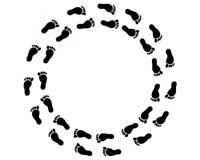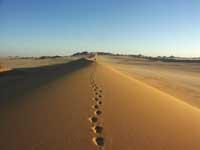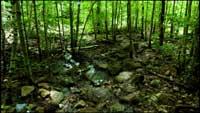No reference, round and round
2010/03/21 Lakar Iraizoz, Oihane - Elhuyar Zientzia

It may seem like a trick to stress the film. But it is related to reality. In fact, in a study conducted at the Max Plank Institute in Germany, it is observed that people tend to make real round tours when they do not take reference in their surroundings. The landmarks can be some tall building, a remote mountain, even the Sun or the Moon. Without them we cannot walk properly.
Science magazine explains that people who are unable to see that they begin to realize in the 1920s tend to worsen their trajectory. To explain this curious trend, it has been said that one leg is longer than the other, which makes us unable to advance properly. But if it were so, we would always lean towards a concrete side, and the German researchers have seen that the error is not systematically done either, but that a single person can take the path to the left, then to the right, to reach the point that finally came out.
It is not surprising that the old researchers do not realize that we lean to one side and the other, since then there was no means to follow the paths of the walkers. Now it is possible, because by GPS you can know where a certain person has gone.

In those who could not see the sun, walkers ended up making circles in the desert (Photo: www.fjexpedition.com/A. Zboray). ...
Researchers at the Max Plank institute have conducted GPS tracking in their research. They took nine people and told them to be as upright as possible, some in the Sahara desert and others in the Bienwald forest, a vast, flat German forest.
Four days after nine they passed through the forest on a slope, and the four made paths. Three of them, in addition, passed over and over the footsteps they left, without realizing it. Two other people were also in the forest, but they could use the Sun as a reference and made an almost direct tour.
The other three participants were transferred to the Sahara desert. Two of them did the test during the day and did not make the way properly, but did not circulate. The third of the participants was at night and could only enjoy the Moon in some sections. For when the Moon hid behind the clouds, the wayfarer went astray.
Brain error

In closed forests it is more difficult to take references and finish circular (Photo: Mossaiq).
Apart from the explanation of leg length, researchers believe that the origin of this strange behavior is in the brain. Apart from the external references, the inner ear of the brain (specifically the system that helps us maintain balance) and the sensors of muscle and joint movement report on the path that is being made.
But these informants are wrong, they make small mistakes. Therefore, the one who walks thinks that he advances correctly, but really turns. And when references fail to correct that erroneous perception of the straight line, it can happen that errors point the pedestrian towards a certain direction and that this progressive worsening ends up causing a 360 degree course.
Published in 7K.

Gai honi buruzko eduki gehiago
Elhuyarrek garatutako teknologia




